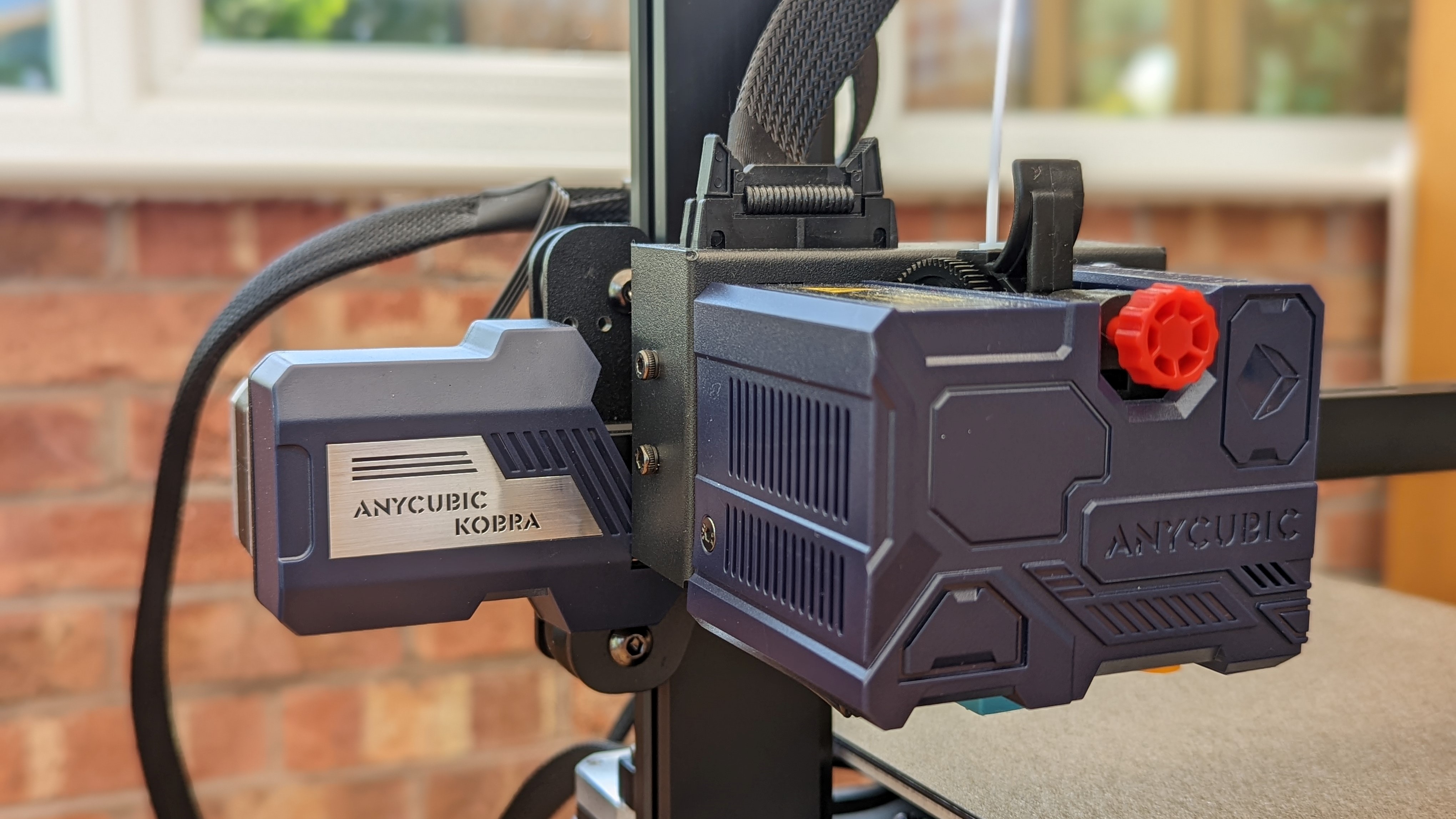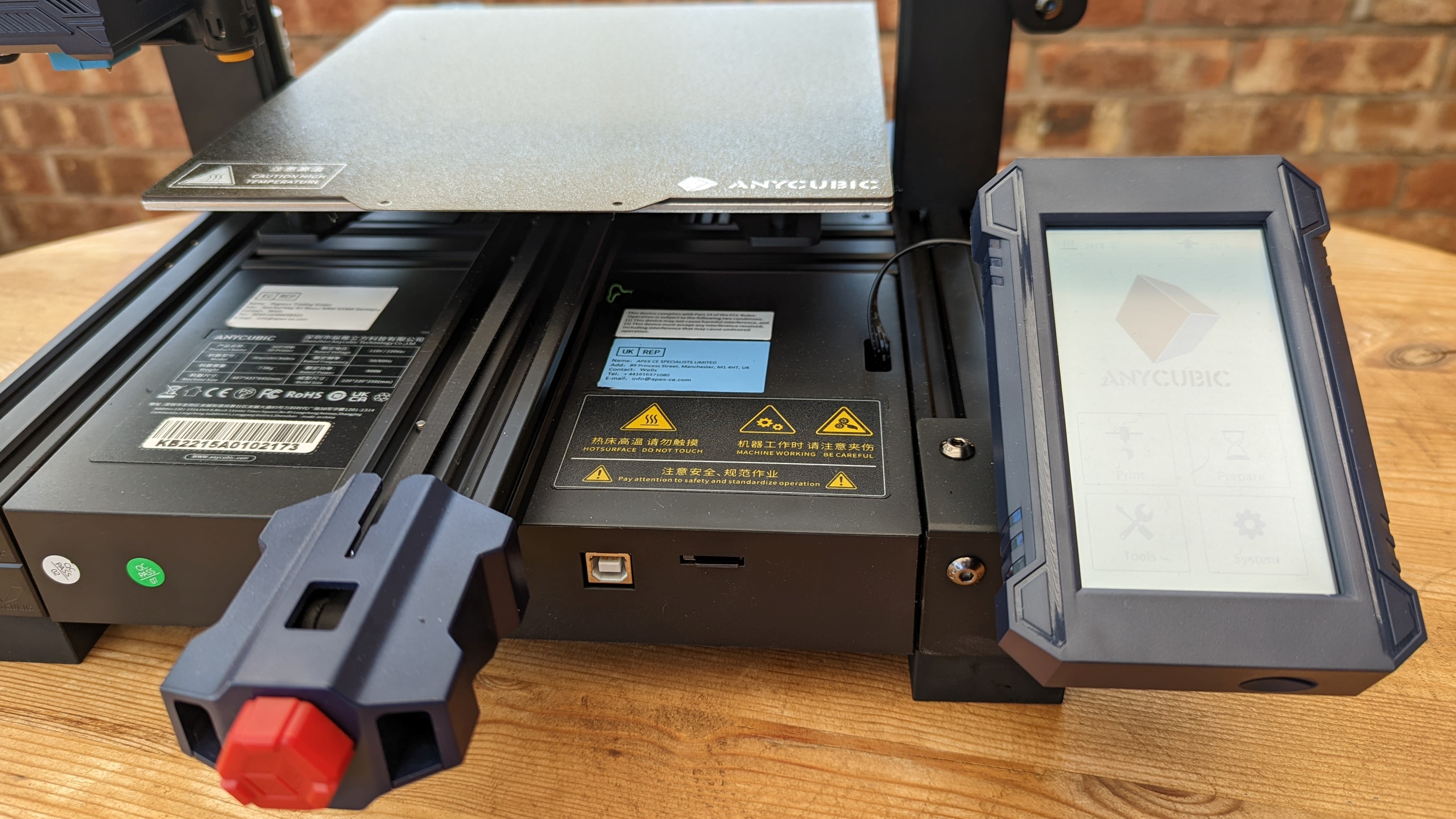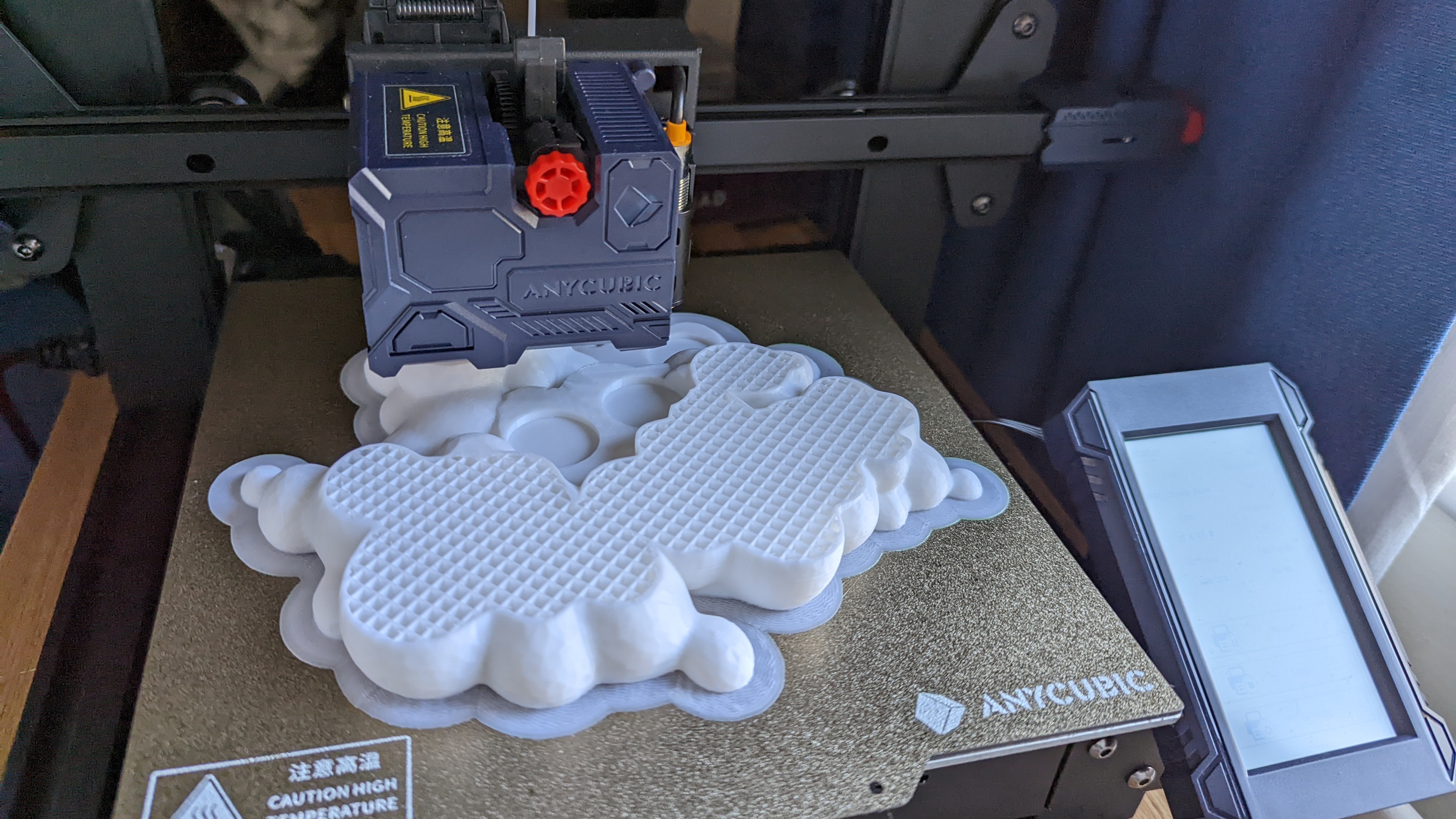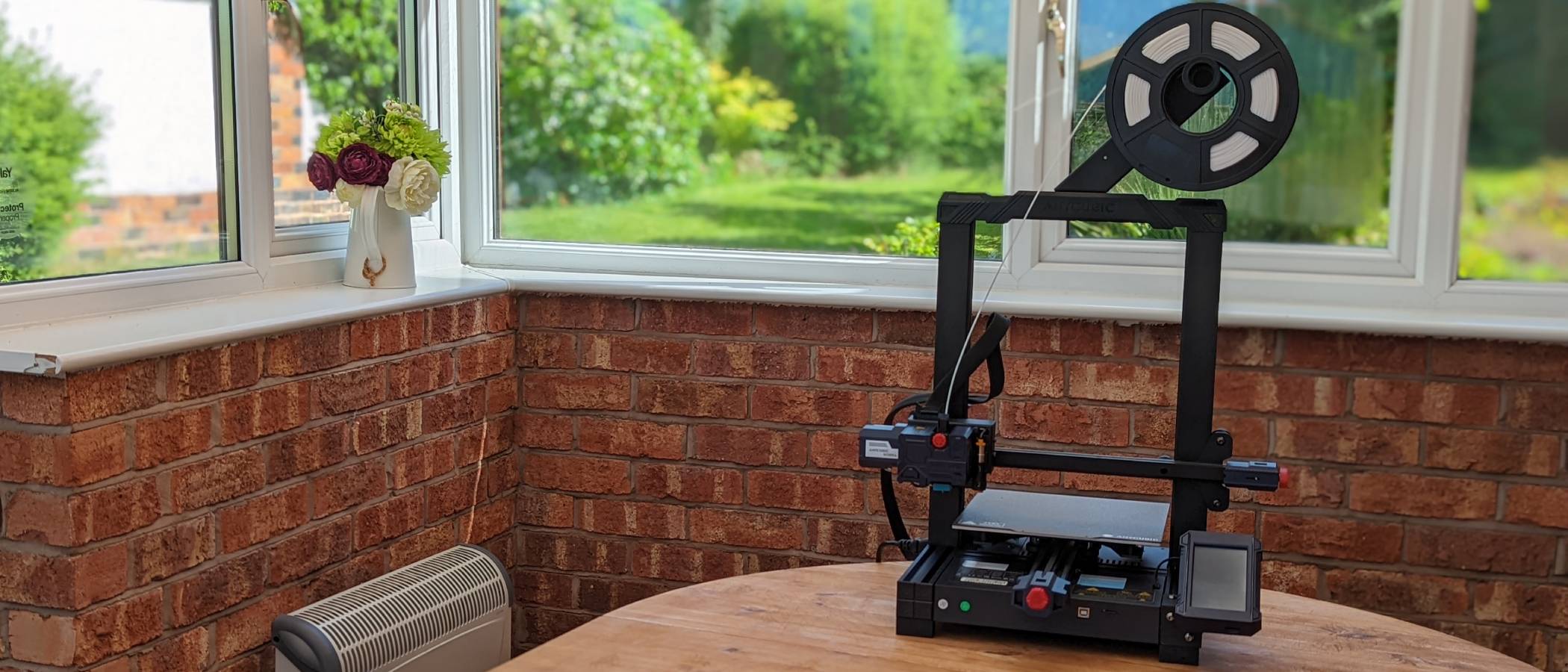TechRadar Verdict
The Anycubic Kobra is an excellent 3D printer for those looking to start printing for the first time or upgrade from a cheaper model. It’s easy to assemble, and once everything is in place - and the auto-calibration is complete - you can start printing without needing to delve into the settings.
Pros
- +
Automatic bed leveling
- +
Easy to construct
- +
Fairly budget-friendly
Cons
- -
Uses microSD cards
- -
Excessive initial stringing
- -
Struggles with small, detailed prints
Why you can trust TechRadar
One-minute review
The Anycubic Kobra is a brilliant FDM (fused deposition modeling) printer for those looking to get started in the world of tinkering, or looking to upgrade from an older model.
It comes in at a fairly budget-friendly price, just $300 / £270 / AU$470 from the Anycubic website. For that, you’ll get a printer with an auto-bed leveling system (which is sure to delight novices and experienced printers alike) as well as intuitive touch screen controls that give you easy access to all of the printer’s features and settings.
Plus, out the gate, it produces some high-quality prints. Sure there are areas for improvement, but if you’re looking for a setup that will work out of the box - and won’t require you to tinker about with settings you don’t yet fully understand - then that’s what the Anycubic Kobra delivers.
Though, before you get too excited, you might want to consider what you’re using the printer for.
If you’re looking to create quick prototypes or larger, less complex models, then this is the kind of system you want (thanks to its large 9.8 x 8.7 x 8.7 inch (220 x 220 x 250 mm) build space). But if you’re instead hoping to create complex figurines for a tabletop game or highly detailed statuettes to adorn your desk, then you’ll want to grab a resin printer instead.
Price and availability
The Anycubic Kobra can be bought for $300 / £270 / AU$470 from the Anycubic website, Amazon US, and Amazon UK.
At this price, it’s not quite the cheapest option out there but is still affordable enough for someone looking to nab their first-ever 3D printer. It’ll also suit someone looking to upgrade from a cheaper model.
This matches up with the Anycubic Vyper, a previous FDM printer from the brand that was similarly budget-friendly and offered decent features for its price.
Design
The Anycubic Kobra’s black aluminum alloy frame is accented with dark navy and red plastic casings. Its utilitarian design won’t win any beauty competitions, but it does ensure the Kobra does the best job it can when printing your 3D models.
Printing Technology: FDM
Supported filaments: PLA, TPU, ABS, PETG
Build Volume: 9.8 x 8.7 x 8.7 inches / 220 x 220 x 250 mm
Print resolution: 0.05mm - 0.3mm
Positioning accuracy: X/Y 0.0125mm; Z 0.002mm
Extruder number: Single; Nozzle diameter: 0.4 mm
Print Speed: 20 - 100 mm/s (recommended 80 mm/s)
Ambient Operating Temperature: 8°C - 40°C
Operational Nozzle Temperature: 500 °F / 260 °C
Operational Hot Bed Temperature: 230 °F / 110 °C
Connection mode: SD Card
Machine size: 19.1 x 16.9 x 19.2 inches / 486 x 430 x 487 mm
Weight: Machine weight: ~7kg
The Anycubic Kobra comes in parts that need to be assembled like IKEA’s flat-pack furniture. Construction isn’t too complex - and with the instructions, you should have a clear idea of what to do - though if you can, we’d recommend grabbing someone to help.
The metal parts have a hefty weight to them and the screws have to be inserted up through the machine's base. As such, it can be difficult to hold everything in place while also tightening the screws with just two hands. But with another person lending their assistance, you should have the Anycubic Kobra together in no more than 30 minutes.
Building is made especially easy as all the tools and screws you need come packaged in the box - so there’s no need to go out and buy any specialist equipment.
That said, one other thing to watch out for during setup is to make sure the metal build plate hasn’t come off with the packaging (as ours did). The gold-colored plate should snap back into place super easily thanks to the base’s magnetic field, but you’ll want to make sure it’s definitely attached before going to auto-level the printer.
If you don’t, the sensor that detects the plate to stop the nozzle from descending too far won’t work correctly and your nozzle could embed itself into your printer and cause serious damage.
On the topic of the build plate though, it is pretty nifty. That’s because it has a slightly rough texture to it that won’t affect your prints, but is designed to make them really easy to remove once they’ve cooled a bit.
From our testing, this feature works exactly as intended. Even though there’s a plastic scraper in the box we never needed it to remove what we had printed from the build plate - provided we were happy to wait a few minutes for everything to cool.

The only design gripe we had was the Anycubic Kobra’s reliance on a microSD card for transferring files from your PC to the printer. While the printer does include one in its box - and also comes with a USB adapter so you can plug it into your PC - we just aren’t fans of these small little storage devices.
Not only are they much easier to lose than a regular USB stick because they’re smaller, you’re less likely to have a spare microSD lying around - so when you inevitably lose the included one you’ll need to go out and buy another or wait for one to be delivered.
Features
One of the most-user friendly features of the Anycubic Kobra is its auto-bed leveling.
To print an object, the Kobra and other similar 3D printers extrude molten plastic through a nozzle onto the bed. If the distance between the nozzle and the bed isn’t constant across the whole bed then your builds will have an inconsistent quality to their layers.
Manual leveling is a fiddly process that requires the careful adjustment of screws while you stare constantly at a spirit level. Auto-bed leveling removes all the hassle and the printer does it for you.
This feature won’t be present in some less expensive 3D printers, so if you can afford to spend a little extra for the Kobra we’d strongly recommend you do just for the auto-leveling alone.
Another helpful feature is the printer’s direct-drive tool head. In simpler terms, that means the Kobra’s extruder components are all packaged into one single front-mounted object, with an easy-to-find port on the top for you to insert the filament.
The instruction manual takes you through the process, but it’s as simple as pushing a button and carefully feeding the plastic filament into the obvious hole. The only issue with this process is that there’s a lot of initial stringing - where newly melted plastic leaks through the nozzle.
It’s easy enough to clear up - and it hardens incredibly quickly - but you will have to wait around for a minute or so before the printer calms down and the stringing stops.
Lastly, there's the Anycubic Kobra’s touch screen. This intuitive interface allows you to interact with the printer’s settings and start prints with ease. It’s situated on the front of the print and sits at a slight angle so you can easily read the display without having to bend down.

Beyond the printer itself, the included microSD card stores a copy of Ultimaker Cura that you’ll want to install on your PC. Once you’ve set Ultimaker Cura up for the printer’s settings (the Kobra’s instruction guide will take you through it) you can start using it to slice STL files to get them ready to print.
Whether you’re downloading a publicly available 3D model or using CAD software to create your own, it’ll likely exist as an STL file. The Kobra can’t do anything with this type of file though, it first has to be sliced - literally sliced up into many layers that are then printed one at a time by the Kobra.
Ultimaker Cura is what’s called slicing software - it can turn STL models into a format the Kobra can use - and it’s fairly intuitive, if not a little basic.
Performance
Thanks to its decent bed size, the Anycubic can produce prints that are up to 9.8 x 8.7 x 8.7 inch big (220 x 220 x 250 mm). It also boasts an average print speed of 80mm/s - this is fairly quick but expect most sizable prints to take at least a few hours, if not a lot longer. In testing, we had models print for over 24 hours - though this is common for 3D printers if you want to make something big.
To put this 3D printer through its paces we used three benchmarks, or ‘torture tests’, to see how well it performs. We printed all of these using the Kobra’s out-of-the-box settings, and we were impressed with the results.
The classic 3DBenchy boat was rendered incredibly well. The smooth sides could convince you this was made as a single piece rather than using many layers of plastic, and the boat's features were recreated expertly. There were some minor stinging issues on the cabin walls, but these could be easily fixed with some smooth sandpaper.
We saw similarly impressive results from the All In One 3D Printer test. The many structures (which included tubes, holes, and bridges) were each recreated with relative ease. Our only concerns were there was a fair amount of stringing and the overhang tests had a drop in quality at the 70-degrees mark - though no prints completely failed.

That said, for out-of-the-box settings, we were impressed. If you’re confident enough to try tweaking the settings, then you should be able to improve the Kobra’s performance, but if you’re a beginner who just wants to get printing without any hassle, then this Anycubic printer performs more than well enough.
Of course, you don’t just want to print benchmarks with your printer. We also put the Anycubic Kobra through its paces by printing out a few longer projects. This included a small storage box that looks like a book and cosplay props based on items from one of our favorite games: Destiny 2.
Once again, the Kobra performed admirably. The book-shaped box was sturdy, and the edge that was designed to be folded did so without snapping. The sci-fi gadgets also looked great.
After the over 24-hour print job was finished we found that larger parts of our props (with only minor detailing) looked identical to their in-game counterparts - though smaller, more intricate pieces were impossible to get right even after multiple attempts.
This is standard for FDM 3D printers though, with resin printers like the Anycubic Photon M3 being the preferred choice for small yet complex prints - i.e. figurines used in Dungeons and Dragons.
Buy it If
You’ve not 3D printed before
Thanks to beginner-friendly features like its auto-bed leveling and its well-tuned default settings, the Anycubic Kobra is an excellent choice for 3D printing novices.
You’re after a ‘next-step’ printer
The Anycubic Kobra isn’t just for beginners, mind you; its decent size and great print quality make it a solid choice for someone looking to replace an older printer or grab a second for their workshop.
Don’t Buy it if
You want to print small, yet complex objects
FDM printers like the Kobra aren’t suited to making small, highly detailed projects like the miniatures used to play Dungeons and Dragons. If that’s what you’re hoping to create, we’d recommend getting a resin printer like the Anycubic Photon M3.
You don’t know what you’d use it for
We know 3D printers are cool pieces of tech, but they can easily be one of those gadgets you buy, use a couple of times, and then let gather dust. If you’re not bursting with ideas of stuff to print, and you aren’t content with letting a $300 device sit idly in the corner of your room, then this might not be a device for you.

Hamish is a Senior Staff Writer for TechRadar and you’ll see his name appearing on articles across nearly every topic on the site from smart home deals to speaker reviews to graphics card news and everything in between. He uses his broad range of knowledge to help explain the latest gadgets and if they’re a must-buy or a fad fueled by hype. Though his specialty is writing about everything going on in the world of virtual reality and augmented reality.
